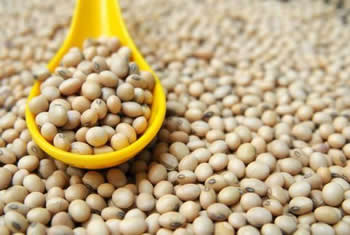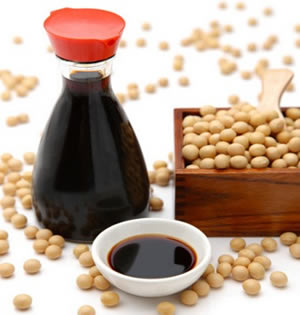Difference between Soya and Soy Sauce
Key Difference: Soy or Soya is also known as soybean or soya bean. It is a type of legume, similar to peanuts, kidney beans, peas, etc. Soy sauce or soya sauce is a sauce that is made via fermentation of soy bean. Hence, soy sauce is a byproduct of soya.
 Soy or Soya is also known as soybean or soya bean. It is a type of legume, similar to peanuts, kidney beans, peas, etc. There are many different varieties of soy bean. Soya bean is actually native to East Asia, but has become popular enough to become a staple past of the Western Diet. In fact, the United States and Brazil are the largest producers of soy bean in the world. Together they produce 72% of the world’s total supply of soy bean.
Soy or Soya is also known as soybean or soya bean. It is a type of legume, similar to peanuts, kidney beans, peas, etc. There are many different varieties of soy bean. Soya bean is actually native to East Asia, but has become popular enough to become a staple past of the Western Diet. In fact, the United States and Brazil are the largest producers of soy bean in the world. Together they produce 72% of the world’s total supply of soy bean.
Soy bean is very high in protein, due to which it is a very popular alternative to meat, especially in vegetarian and vegan diets. Soy bean has many different applications, such as soy vegetable oil, soy milk, tofu, and tofu skin. In addition, soy bean can be fermented to make soy sauce, fermented bean paste, natto, tempeh, and others. Soy bean is also further used to make products such as textured vegetable protein (TVP), also known as soya chunks or soya granules, which is sold in its dehydrated form. The benefit of this is that in its dehydrated form, the TVP can be stored for up to 12 months. This and the fact that it is an excellent source of protein makes it a great grain for both human and animal consumption, especially in third world countries as it is a cheap alternative for meat.
Soy sauce or soya sauce is just one of the many functions of soya bean. In order to make soy sauce, the soy beans are first boiled and then mixed with roasted grain, brine, and Aspergillus oryzae or Aspergillus sojae molds. This mixture is then fermented. After fermentation, the mixture is made into a paste, which is then pressed to produce a liquid. This liquid is what is called soy sauce. The leftover mixture is used as animal feed.
 Soy sauce is a popular condiment, which is commonly used in Oriental cooking. Soy sauce dates back to the 2nd century BCE in China. Since then it has a staple in cooking, as well as a condiment in East and Southeast Asian cuisines. Its popularity has grown and spread all over the world since its humble origins. It is now commonly used in Japan, Taiwan, China, Korea, Indonesia, Vietnam, Burma, as well as other countries.
Soy sauce is a popular condiment, which is commonly used in Oriental cooking. Soy sauce dates back to the 2nd century BCE in China. Since then it has a staple in cooking, as well as a condiment in East and Southeast Asian cuisines. Its popularity has grown and spread all over the world since its humble origins. It is now commonly used in Japan, Taiwan, China, Korea, Indonesia, Vietnam, Burma, as well as other countries.
There are now a variety of different soy sauces produced, such as light soy and dark soy, which are just the tip of the ice berg. The variations in taste and texture are achieved via different methods and durations of fermentation and through different ratios of water, salt, and fermented soy. Sometimes other ingredients are also added either to the mixture or to the sauce to give it a different taste. Some types of soy sauce are also aged for different times to give it a stronger flavor. This is especially true for dark soy sauces. Dark soy sauces also tend to be richer and slightly sweeter than light soy sauces. Some other varieties of soy sauce include thick soy sauce, mushroom soy sauce, shrimp soy sauce, etc.
Comparison between Soya and Soy Sauce:
|
|
Soya |
Soy Sauce |
|
Type |
Legume |
Condiment |
|
Made From |
Nature |
Soya bean |
|
Form |
Solid (bean) |
Liquid (sauce) |
|
Uses |
As grain, as well as to make soy vegetable oil, soy milk, tofu, and tofu skin. Also fermented to make soy sauce, fermented bean paste, natto, tempeh, and others. As well as textured vegetable protein (TVP), also known as soya chunks or soya granules. |
Garnish, sauce, flavoring, and as an ingredient in many oriental dishes. |
Image Courtesy: thehindubusinessline.com, buzzle.com









Add new comment